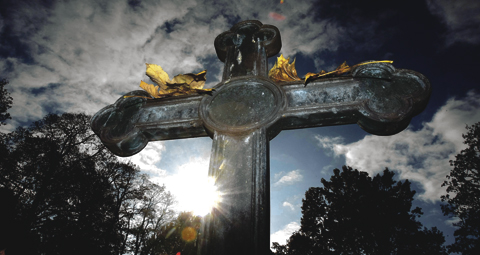November 2 | ![]() 0 COMMENTS
0 COMMENTS ![]() print
print

Death is a new rebirth
— In the month of the Holy Souls, MARY McGINTY looks at Catholic teaching and bereavement in a new SCO series
The sadness of death gives way to the bright hope of immortality. This is our belief as Catholics. For us it is more a beginning than an end and even in the depth of the inevitable grief of parting we are consoled by the knowledge that in dying we will be reborn to eternal life.
The Church teaches us that life is a journey towards death and the opening of the door to our eternal reward. In his encyclical Evangelium Vitae Blessed Pope John Paul II wrote that ‘life on earth is not an ‘ultimate’ but a ‘penultimate’ reality’ and that life ‘remains a sacred reality entrusted to us to be preserved with a sense of responsibility and brought to perfection in love and the gift of ourselves to God and to our brothers and sisters.’
In an increasingly secular world dying is met with fear and death is seen as the enemy of life. Our consumer-driven culture, in which the acquisition of material goods and the relentless quest for financial success, can offer only transient pleasure without real meaning. Whether we face dying with courage and openness or turn our faces to the wall death will still visit us. Our hearts will stop beating, we will breathe our last breath and our spirit will depart our earthly bodies. But death is not a failure and life is changed not ended.
As Pope Benedict XVI tells us: “Illuminated by the Faith, we look to the human enigma of death with serenity and hope. Indeed according to Scripture, more than being an end, death is a new birth, the obligatory passage through which those who model their earthly existence according to the Word of God may achieve the fullness of life.”
Coping with loss
Unlike in past centuries when maternal and childhood death were commonplace and disease ravaged the population death no longer shapes life. Then each new day that dawned was a preparation for death while in the 21st century advances in medicine have made recovery from very serious illness often a realistic expectation. Good care and nutrition see the elderly live longer than ever before. With the increased probability that we will live far longer than our predecessors preparation for death has diminished as a consequence.
With death a seemingly distant inevitability we no longer speak of the subject with any ease and conversations, when they do take place, are uncomfortable to the point that they are can be perceived as being in bad taste. The result of lack of discussion is unnecessary fear and feelings of isolation. In fact, discussions about death and dying are healthy and constructive; Living and Dying Well the Scottish Government’s action plan for end of life care confirms that growing recognition that societies’ attitudes to death, dying and bereavement play an important role in the long-term health and well-being of individuals and communities. Talking about dying is often the first step towards a good death.
Fear of suffering is usually the barrier to real consideration of the subject but suffering has many facets, not solely physical pain. Improved palliative care has ensured that any pain that might be suffered is as minimal as possible but, according to Sr Rita Dawson, the chief executive of St Margaret of Scotland Hospice, without addressing the suffering of the soul a good death is more difficult.
“If you are knocked down in the street there is no guarantee that it will be a pain-free experience—far from it. Even when the paramedics arrive they have first got to assess your condition,” she explained. “And no pregnant woman would ever expect to be assured that the birth of her baby will be without any suffering. But suffering is much more than physical pain.”
“Our job is to make the end as pain free as possible and we do that very successfully, but in my experience the real pain comes from emotional and spiritual suffering. In the hospice we walk with our patients on that last journey and instead of loneliness and fear their last days are a time of peace and resolution. As well as making the end easier it makes the mourning healthier for the family.”
In the hospice, spiritual preparation is a central tenet to end of life care. While the wishes of those who have no faith or spiritual inclinations are respected spiritual care defines the atmosphere and characterises each and every action that takes place.
Space and openness
Nita Harkins of the Catholic Nurses Guild agrees with Sr Rita that time, space and openness to the patient’s spiritual needs are crucial to a good death.
“The dying patient should have as much privacy as possible—preferably a single room—and the family should be encouraged to visit as often as possible,” Mrs Harkins said. “They need a lot of support and there are often unresolved issues that need to be dealt with.”
“The Royal College of Nursing says that ‘dignity is at the heart of everything we do’ and the Catholic nurse, like the Catholic doctor, knows that we are made in the image and likeness of God and therefore we should see Christ in all our patients and treat them accordingly. These days, because patients cannot be asked their religion, nurses need to be extra sensitive to all the dying patient’s needs, listening attentively to what they say and being vigilant to their reactions to what is said to them. Ultimately it is about dignity and sensitivity.”
Our lives are a gift from God but it is in death that they are given their meaning. In dying we leave behind our temporal cares, surrendering ourselves to His goodness.











